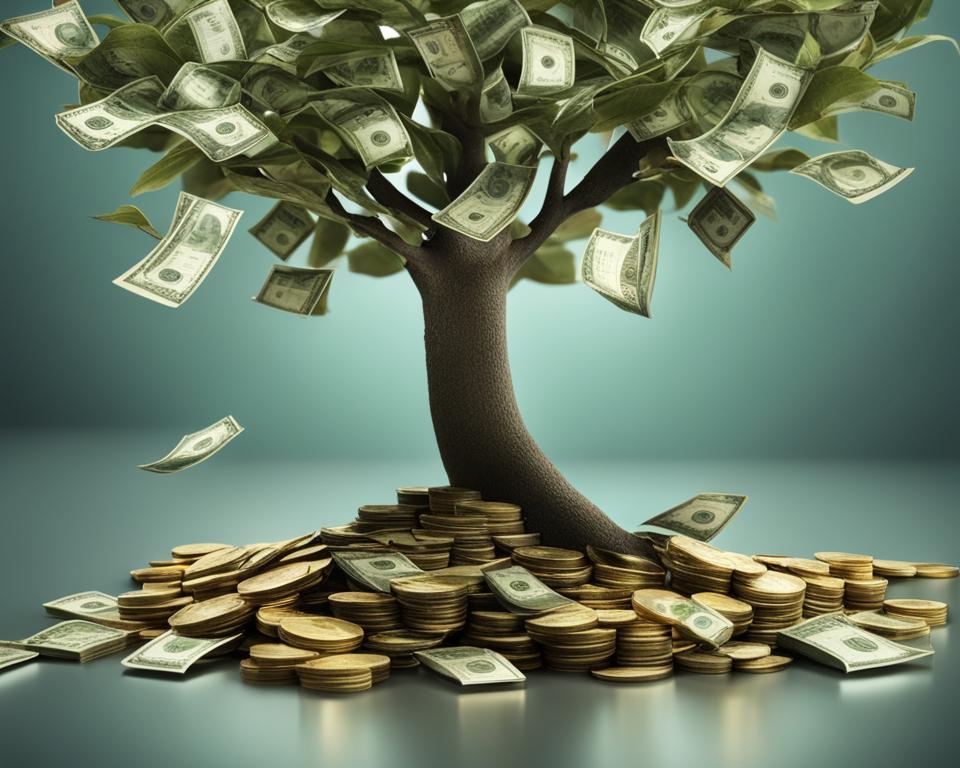Constructing an investment portfolio that thrives on the dual pillars of dividend yield and dividend growth is akin to finding harmony in the financial sphere. Investors, seasoned and novices alike, often grapple with this fundamental challenge in pursuit of sustainable income and the potential for increased payouts over time.
Dividend growth investing elucidates a pathway for investors to engage with stocks that not only promise a steady income stream but also hold the potential for an uptick in dividend distribution. Achieving this equilibrium is no small feat given the backdrop of inflation and market volatility that continually shape the landscape of investment portfolios.
While the allure of immediate high yields can be enticing, it represents only one aspect of an astute investment decision. The cornerstone of a savvy investor’s strategy must encompass a robust evaluation of dividend growth, wherein lies the opportunity for long-term financial prosperity.
Key Takeaways
- Strategically balancing dividend yield and dividend growth is crucial for creating income-generating investment portfolios.
- Dividend growth investing focuses on long-term income sustainability and growth potential.
- Investors should tread carefully between high immediate income and prospects for increasing payouts.
- Understanding and navigating inflation’s impact is critical to preserving the real value of dividend income.
- Patient examination and selection of stocks capable of consistent dividend growth will secure financial health over the horizon.
Understanding the Role of Dividends in Investment Portfolios
Dividends play a pivotal role in financial strategies, striking an attractive balance between immediate income and potential for asset growth. For those seeking to cultivate a robust portfolio, dividends can be the cornerstone of their investment appeal, prompting a closer examination of their various forms and the distinct benefits they offer. Such an exploration can reveal why some options are considered the best dividend growth stocks, and how the nature of dividends enriches an investor’s portfolio.
The Basics of Dividends and Their Appeal to Investors
At their core, dividends are a share of a company’s profits paid out to shareholders, serving as a reward for their investment. The attraction of dividends lies in their ability to provide a consistent and predictable income stream, a feature particularly favored by retirement-focused investors or those seeking a stable return on their investments.
Moreover, dividends stem from well-established companies with proven profitability, amplifying their allure as they typically signal financial stability and a reliable track record. Consequently, companies that issue regular dividends have a favorable view among investors, as they reflect a commitment to sharing success and maintaining shareholder trust.
Regular vs Special Dividends and Their Impact
Understanding the types of dividends—regular and special—is key when curating an investment portfolio. Regular dividends are paid at set intervals, generally on a quarterly basis, which investors count on for steady income. These payments are often seen in the best dividend growth stocks, where companies have both the intention and the ability to increase these dividends over time, thus enhancing the investment appeal of the stock.
In contrast, special dividends are distributed on an ad hoc basis, often after financial milestones such as extraordinary earnings or the sale of a business unit. While they can be lucrative, their unpredictable nature can make them less of a steady investment strategy and more of an occasional benefit.
In conclusion, dividends—whether regular or special—can significantly boost the attractiveness of an investment, granting it a pivotal place in the diversification and resilience of a portfolio. Understanding their role is crucial for investors seeking to maximize investment appeal through companies that provide regular dividends and show potential for growth.
Dividend Yield vs. Dividend Growth: The Core Concepts
When crafting a dividend growth strategy, investors often encounter two critical but distinct concepts: dividend yield and dividend growth. These elements play pivotal roles in the composition of an investment portfolio, as they represent different approaches to achieving long-term gains. While dividend yield denotes the immediate income as a percentage of the stock’s price, dividend growth signifies the increase in dividend payouts over time. A keen understanding of the interplay between these concepts is essential for investors aiming for sustained profitability.
Image placement for dividend yield and dividend growth visual representation:
A high dividend yield might suggest an attractive return in the short term, but it can also indicate potential risks or an undervalued stock. On the other hand, a robust dividend growth strategy underscores a company’s confidence in its future performance, often leading to a stronger likelihood of long-term gains. The underlying objective for investors is to balance the immediate draw of high yields with the promise of rising dividends, thereby optimizing their returns in the face of inflation and market volatility.
| Dividend Yield | Dividend Growth |
|---|---|
| Immediate income relative to stock price | Increasing dividend payouts over time |
| Useful for short-term income needs | Provides inflation protection |
| May hint at undervaluation or risk | Suggests financial confidence and potential capital appreciation |
| Generally high in maturing companies | Tends to be higher in growing companies |
| Measured annually as a percentage | Assessed by the growth rate in payouts |
To truly benefit from the advantages offered by both dividend yield and dividend growth, investors should lean towards a diversified strategy. This approach should involve levels of scrutiny and selection of companies not just with high current yields, but also those demonstrating consistent and sustainable growth in payouts. Companies with a longstanding record of dividend growth are particularly sought after as they tend to signal strong financial health and a shareholder-friendly approach, laying the groundwork for long-term gains.
“The beauty of a dividend strategy is not just in the immediate rewards, but also in the future prospects it holds. Balancing yield with growth is an art that can lead to rewarding returns and a resilient portfolio.”
Ultimately, investors who prioritize companies with regular and increasing dividends are likely to experience the dual benefit of reliable income today and the potential for appreciable income tomorrow. An effective dividend growth strategy not only provides dividends that keep pace with inflation but also contributes to the compounding effect of long-term gains.
Assessing the Inflation Risk on Dividend Investments
In the landscape of modern investing, inflation is a force that consistently challenges the value of income-generating assets. For investors crafting a dividend growth portfolio, understanding and mitigating inflation risk is essential. By focusing on investment strategies that emphasize growth in dividend payouts, investors may safeguard against the loss of purchasing power that can derail their financial goals.

Real-world Impact of Inflation on Fixed Income from Bonds
Inflation’s bite can sharply diminish the real-world value of fixed-income investments such as bonds. As the cost of living climbs, the fixed interest from these assets buys less, making bonds a potentially weaker choice for investors who require a growing income stream. The scenario below demonstrates this financial conundrum.
| Year | Fixed Bond Income | Real Income After Inflation |
|---|---|---|
| 1 | $50,000 | $48,500* |
| 5 | $50,000 | $44,200* |
| 10 | $50,000 | $40,100* |
*Assuming an average inflation rate of 3% annually; the real income reflects diminished purchasing power compared to Year 1.
Shifting Investment Strategies in Response to Inflation
Investors may seek refuge in a dividend growth portfolio which, unlike fixed-income investments, admits the potential for dividends to rise over time. This dynamic ability to escalate payouts can provide a bulwark against inflation’s erosive effect on investment returns. Consider equity investments with an initial 4% yield. If these equities are poised to increment their dividend payouts annually, they are positioned to potentially outpace inflation. The table below outlines how such an investment strategy could compare favorably to traditional fixed-income bonds.
| Investment Type | Fixed Bond Income | Dividend Growth Portfolio Income |
|---|---|---|
| Initial Yield | 5% | 4% |
| Year 1 Real Income* | $50,000 | $50,000 |
| Projected Year 5 Income* | $50,000 | $58,000* |
| Projected Year 10 Income* | $50,000 | $67,000* |
*Assuming annual dividend growth of 3% to combat inflation, with stable tax rates on dividends.
By deliberately transitioning towards a resilient investment strategy that values dividend growth, investors can design a portfolio with a better chance of weathering inflationary pressures whilst pursuing the dual mandate of income and growth.
Dividend Growth Investing: Building a Forward-Thinking Portfolio
The pursuit of a thriving investment portfolio lies in identifying those golden opportunities that not just exist but grow over time. Dividend growth investing represents such an opportunity, enabling investors to benefit from companies that have not only established a pattern of paying dividends but also show potential for increasing those payouts. This approach underscores the principle of financial stability, where the lure of immediate gains is balanced with a vision for long-term prosperity.
To embark on this journey, savvy investors tap into tools like a dividend growth calculator and anchor their decisions on thorough research, pinpointing dividend growth companies that exemplify the ethos of consistent performance. Let’s delve into the criteria that hone the art of selecting the right stocks for a forward-thinking dividend growth portfolio.
Criteria for Selecting Dividend Growth Stocks
A prudent investment decision involves weighing a multitude of factors that hint at both immediate yields and future growth. Top on the criteria list is the payout ratio, which indicates the percentage of earnings distributed as dividends. A modest payout ratio suggests a company’s foresight in retaining sufficient earnings to fuel future growth, which is conducive to a robust dividend growth strategy.
Investors also seek solace in the financial stability signaled by strong credit ratings, assuring that their selected dividend growth companies rest on solid ground. The historic upward trend in dividends acts as a beacon of commitment to shareholder returns, with each increment painting a picture of growing shareholder value.
Top Dividend Growth Companies and Their Historical Performance
Among the pantheon of dividend growth companies, stalwarts like Bank of America stand out. With a decade’s record of dividend growth, the financial institution exemplifies the resilience and dedication to shareholder wealth that investors covet.
In the span of ten years, Bank of America has moved from modest to more substantial quarterly dividends, reflecting not just financial stability but escalating confidence in its business model and growth trajectory. This transformation echoes the aspirations of investors who, through dividend growth investing, aim to create a financial backbone strong enough to support their future needs and ambitions.
Thus, dividend growth investing is more than a mere strategy; it’s a philosophy that champions the potential for prosperity over time. It requires an investor to be discerning, patient, and strategic — character traits that define the most successful portfolios and the brightest financial futures.
Seeking Safety First in Dividend-Yielding Stocks
When it comes to investing in dividend-yielding stocks, prioritizing financial safety is essential. Wise investors recognize that while high yields can be attractive, they should not come at the cost of long-term security. Focusing on financial stability and reliable dividend growth can ensure a strategy that survives market ups and downs. A diligent approach towards dividend-investing involves using a dividend growth tracker, understanding the yield trap, and assessing a company’s financial health.
Identifying and avoiding the yield trap
Chasing high dividend yields without analyzing the underlying financial health of the company can lead to what is known as a yield trap. This occurs when an investor is lured by a high dividend yield that is unsustainable due to the company’s poor financial health. Often, such high yields are a sign that the market expects the dividend to be cut and the stock price has been driven down as a result.
To avoid the yield trap, investors must look beyond the attractive yield and assess the business fundamentals. A stock with a high yield but weak earnings, heavy debt, or industry headwinds could be a risky bet. Investors should seek stocks with not only high yields but also the assurance of dividend sustainability.
Measuring financial health and stability for long-term security
The cornerstone of a safety-first approach in dividend investing is to measure financial health and stability. Investors should delve into balance sheets, evaluate debt-to-equity ratios, and consider the consistency of dividend payments. Companies should be scrutinized based on their credit ratings, as brands like Standard & Poor’s or Moody’s provide essential insights into a company’s financial endurance.
Utilizing a dividend growth tracker can act as a powerful tool for investors to monitor and analyze trends in dividend payments. It helps to track companies that deliver not just high yields but also exhibit potential for increasing dividends, illustrating long-term growth and financial stability.
Investment safety often lies in the details, and therefore, a company’s history of maintaining or raising dividends becomes an important indicator of its resilience. In summary, selecting dividend-yielding stocks requires a thorough examination of financial stability to secure a reliable income stream.
To encapsulate, dividend growth investing demands a delicate balance between high immediate yield and the prospect of growth. By placing ‘safety first’ and evading the alluring yet often perilous yield trap, investors can strategically hitch their wagon to dividend-yielding stocks that are poised to provide secure and scalable returns.
Strategies to Maximize Dividend Yields
Investors seeking to maximize dividend yields and fortify their income streams need to deploy a set of strategic measures that align with the goal of securing robust dividend flows. This unconventional approach can significantly impact portfolio performance, ensuring that investments are not only resilient but also yield-generating. We shall delve into strategies that emphasize dividend growth strategy, instrumental in constructing a portfolio composed of top dividend growth companies.
To effectively maximize dividend yields, it is crucial for investors to adopt a diversified approach, spreading investments across various sectors and industries. This can protect against sector-specific downturns and provide opportunities for capturing growth in different market conditions. Additionally, identifying companies with low payout ratios and a history of consistently hiking dividends can be a promising avenue to achieving a yield that supports both present needs and future ambitions.
- Diversify Holdings: Broadening the investment spectrum to include a rich diversity of dividend-paying companies can mitigate risks and optimize return potential.
- Prioritize Financial Stability Over High Growth: Sometimes, sacrificing high growth for greater financial stability in companies with moderate yet stable profit increases can be more beneficial for long-term yield maximization.
- Seek Modest Payout Ratios: Companies that retain more earnings typically have more capital to invest in future growth, which in turn can support and increase dividend payouts.
- Focus on Dividend Growth History: Firms known for steadily elevating their dividends often exemplify fiscal health and commitment to shareholders.
- Reinvest Dividends: Employing strategies like Dividend Reinvestment Plans (DRIPs) can compound the growth of an investment, turning modest initial yields into substantial gains over time.
Consciously selecting stocks for their yield potential requires a balance of savvy investment acumen and patient capital deployment. A focus on companies like those found in the S&P Dividend Aristocrats, which have a solid history of progressively increasing dividends, can be central to a dividend growth strategy. The following table illustrates factors to consider when evaluating companies for their dividend-growing prospects and yield maximization potential.
| Factor | Significance for Dividend Yields |
|---|---|
| Diversification | Reduces risks and leverages opportunities across sectors. |
| Financial Stability | Ensures continuity of dividends during market fluctuations. |
| Low Payout Ratio | Indicates room for dividend growth and sustainability. |
| History of Dividend Increases | Suggests a commitment to returning value to shareholders. |
| Dividend Reinvestment | Accelerates the compounding effect on investment growth. |
While high dividend yields can be tempting, they should not be the sole factor guiding investment decisions. Maximizing dividend yields is a dynamic process that calls for consistent evaluation and realignment to optimize returns. The realization of this goal lies in the steadfast pursuit of integrating these multi-faceted strategies into your dividend growth portfolio, ensuring a resilient and rewarding investment journey.
Navigating Market Risks with a Dividend-Oriented Strategy
In the quest for financial stability and growth, investors often gravitate towards dividend growth investing as a means to navigate the inherent market risks of the stock market. This dividend-oriented strategy fulfills the dual objective of offering a buffer against short-term market fluctuations while also providing a reliable source of income. By understanding and comparing the risk profiles of different investment types, especially between an equity portfolio and more traditional bond investments, investors can make informed decisions to tailor their portfolios to their unique needs and time horizons.
Comparing equity portfolio risks with bond investments
Equity portfolios, while offering the allure of capital growth and potentially higher yields through dividends, inherently carry greater volatility in comparison to bonds. Dividends from equities may rise with inflation and corporate growth, providing an attractive investment prospect for those looking toward the future. However, unlike bonds which typically offer fixed interest payments, dividends are not guaranteed and are subject to the company’s financial health and board decisions. Understanding these distinctions enables investors to weigh their options more accurately and manage expectations regarding risks and returns.
Maintaining a balance between market fluctuations and steady income
A critical aspect of dividend growth investing is striking an optimum balance between exposure to market risk and the quest for steady, dependable dividend income. This balance is ever more crucial for those approaching retirement, where predictable income becomes paramount. For younger investors with a longer time horizon, a higher tolerance for market volatility can be offset by the long-term benefits of reinvesting dividends to achieve compound growth. Therefore, adjusting the asset mix in one’s equity portfolio to align with their stage in life and investment goals is a key tenet of a calibrated dividend-oriented strategy.
Investors should consider diversifying their portfolio across various sectors and dividend-yielding stocks, such as those featured in the S&P Dividend Aristocrats, to mitigate risks and enhance potential income. By employing a balanced approach toward dividend-yielding investments across an array of industries, the risks associated with market swings can be better managed, paving the way for a strategy that nurtures both the income needs of today and the growth aspirations of tomorrow.
Dividend Growth Tracker Tools and Techniques
Investors focused on dividend investing techniques often turn to cutting-edge dividend growth tracker tools. These tools offer up-to-the-minute data on dividend payment schedules, yield percentages, and historical dividend growth rates. They are indispensable for investors who need to make informed decisions about their portfolios and are seeking to optimize their returns.
An effective dividend growth tracker provides a comprehensive overview of one’s investment performance, highlighting the successes and signaling when adjustments may be needed. The insights gleaned from these trackers allow investors to identify trends, compare anticipated versus actual income, and sharpen their dividend investing techniques.
Let’s explore some key capabilities and benefits offered by these tools:
- A well-designed dividend growth tracker simplifies the process of monitoring individual stock performance, especially pertaining to dividend history and growth.
- Trackers help reveal the sustainability of a company’s dividend over time – a critical factor for avoiding high-yield traps that may indicate financial instability.
- These tools assist in strategic planning, as they can illustrate yield percentages across a portfolio, helping in the allocation of assets to achieve desired income levels.
- Some trackers go a step further to provide alerts for upcoming dividend payments, helping investors stay up to date and potentially informing buy or sell decisions.
A well-balanced portfolio that prioritizes both safety and growth is often the result of proficient use of these trackers. Below is an example of how investors might use a dividend growth tracker to compare performance across different investment sectors:
| Sector | Dividend Yield | 5-Year Dividend Growth | Payout Ratio |
|---|---|---|---|
| Consumer Goods | 3.2% | 5.8% | 55% |
| Healthcare | 1.9% | 7.5% | 42% |
| Technology | 1.1% | 10.4% | 35% |
| Utilities | 3.7% | 2.1% | 75% |
It’s through these functionalities that dividend growth trackers prove their worth time and again. By leveraging detailed, actionable data to inform their investment activities, investors can fine-tune their strategies, aligning them with the dual objective of achieving robust yields and fostering growth.
Successful dividend growth investing hinges on blending adept investment choices with reliable data. Tools that track the trajectory of dividends are becoming a centerpiece for investors aiming to sculpt resilient portfolios that stand the test of economic shifts and market fluctuations.
To maximize the benefits of these tools, investors should remain engaged, regularly revisiting their dividend strategies and ensuring they are aligned with their long-term financial objectives. In the dynamic world of dividend investing, the astute use of a dividend growth tracker can be the difference between an ordinary and an extraordinary portfolio performance.
Exploring the Benefits of Dividend Reinvestment Plans
For investors aiming to maximize their portfolio’s potential, dividend reinvestment plans (DRIPs) stand out as a compelling option. These plans offer the perks of compounding growth, transforming the dividends received into additional shares of the company. Over time, this reinvestment amplifies an investor’s stake in the firm, potentially leading to significant growth in the value of their investment.

How DRIPs contribute to compounding growth
DRIPs harness the power of compounding, which Albert Einstein once described as the eighth wonder of the world. As dividends are reinvested to purchase more shares, shareholders benefit from growth in two ways: the appreciation of the stock’s value over time and the increase in the number of shares owned. These two factors combine to potentially accelerate an investor’s portfolio growth, creating a virtuous cycle of compounding returns.
Practical steps to set up a DRIP with your investments
Setting up a DRIP is a straightforward process that can generally be done through the investor’s brokerage account. Here’s how to get started:
- Check if your stock is eligible for a DRIP. Many companies offer these plans directly, while others can be managed through a brokerage.
- Sign up for the DRIP program with the company or through your brokerage, which may involve selecting the option to reinvest dividends automatically.
- Monitor your investments regularly to see your dividends being reinvested and the number of shares you own progressively growing.
- Keep track of your cost basis for tax purposes, as reinvested dividends can affect your tax liabilities when you eventually sell the shares.
The implementation of DRIPs in your investment portfolio could serve as a strategic move to achieve sustained financial growth. It’s a powerful technique that allows investors, especially those not relying on dividend income for current expenses, to potentially build wealth over the long term as part of a disciplined financial strategy.
How to Perform a Dividend Stock Analysis
Dividend stock analysis is a cornerstone of income investing, providing a fundamental understanding of a company’s financial sustenance and potential for growth. This analysis dives into the past performance of dividend distributions and inspects the future capability of a company to maintain or increase these payouts. By exploring both historical and predictive aspects, investors can navigate the often complex terrain of dividend investing with greater confidence.
Evaluating a company’s dividend history and growth potential
To gauge the reliability and sustainability of dividend payments, one must examine a company’s dividend history. This includes not just the frequency and amount of past dividend payouts but also how those dividends have grown over time. A long and steady history of increasing dividends can be indicative of a company’s robust financial health and a commitment to returning value to shareholders. Conversely, irregular or decreasing dividends may signal underlying issues or a need for caution among income-focused investors.
Indicators such as the dividend payout ratio, which shows the proportion of earnings paid out as dividends, and the retention ratio, highlighting the portion of earnings reinvested in the company, provide critical insight into future dividend growth potential. Companies that manage to strike a balance between rewarding shareholders and reinvesting for growth often emerge as attractive candidates for income portfolios.
Utilizing dividend growth calculators to forecast returns
Forecasting the future performance of dividend-paying stocks is where dividend growth calculators become invaluable. These calculators allow investors to project potential future dividend payouts based on a variety of inputs, including current dividend yield, expected dividend growth rate, and investment horizon. By simulating how dividends might grow over time and what that means for individual investment returns, these calculators can help in shaping a more strategic investment approach.
The diligent use of a dividend growth calculator can illuminate the path towards a robust dividend strategy, helping investors to estimate and compare the long-term benefits of investing in different dividend-paying companies.
Here is a representative table outlining the impact of dividend growth on investment returns:
| Year | Initial Dividend Yield | Dividend Growth Rate | Projected Dividend Payout |
|---|---|---|---|
| 1 | 3% | 5% | $30 |
| 5 | 3% | 5% | $38.29 |
| 10 | 3% | 5% | $49.12 |
| 15 | 3% | 5% | $63.10 |
| 20 | 3% | 5% | $81.18 |
Note: The projected dividend payout is calculated on a per-share basis, assuming a continued annual growth rate.
Performing a comprehensive dividend stock analysis helps investors to differentiate between companies that merely offer a high yield and those that also promise growth, thereby aligning their investment goals with the right opportunities. The insights garnered through such analysis are essential for building a dividend portfolio poised for success.
Portfolio Allocation: Blending High Yield with Growth Prospects
As investors strive for a robust and dynamic approach to portfolio management, the concept of blending high dividend yield with solid growth prospects presents an alluring avenue for diversification. Not only does this strategy aim to provide a stable source of income, but it also opens up the potential for significant capital appreciation, catering to a spectrum of financial objectives and risk tolerances.
Benefits of blending strategies for diversification
Adopting a strategy that marries the reliability of high yield stocks with the promise of growth-oriented investments paves the way for enhanced portfolio resilience. Yield-focused equities tend to provide a cushion during market downturns, thanks to their steady payout structure. Conversely, growth stocks offer the potential for value appreciation, capitalizing on the dynamic shifts in the business environment. Together, they create an investment synergy that harnesses the combined strength of income and evolution, leading to a more balanced and fortified portfolio profile.
Examples of balanced portfolios that harmonize yield and growth
To illustrate the efficacy of blending high dividend yield stocks with growth-driven securities, let’s consider a sample portfolio that showcases harmony between the two strategies. This exemplar portfolio is crafted with a select mix of securities that demonstrate both resilience and a trajectory for expansion, providing an integrated snapshot of how portfolio allocation can be optimized.
| Investment | Dividend Yield | 5-Year Growth Rate | Sector |
|---|---|---|---|
| Johnson & Johnson | 2.6% | 6.8% | Healthcare |
| Microsoft Corporation | 1.0% | 20.1% | Technology |
| The Coca-Cola Company | 3.2% | 4.5% | Consumer Goods |
| NVIDIA Corporation | 0.2% | 37.8% | Technology |
| Procter & Gamble Co. | 2.4% | 7.9% | Consumer Goods |
The chosen equities above signify how a proficiently blended strategy can capture the essence of both worlds: the security that comes from high dividend yield and the growth prospects embedded within rapidly advancing sectors like technology. Applying fundamentals of portfolio allocation along these lines not only satisfies the demand for immediate cash flow but also positions investors strategically for long-term wealth accumulation.
Such a multifaceted approach to portfolio construction underscores the sagacity of blending strategies, ensuring investors can adapt to market environments that favor either income or growth, thereby reducing overall portfolio volatility and enhancing the potential for lucrative returns.
Crafting a Dividend Growth Strategy
Creating a plan for income growth is critical for investors who seek to build lasting wealth, particularly through dividends. Crafting a dividend growth strategy may seem daunting, but it hinges on established principles that evaluate a company’s ability to maintain and potentially increase its dividend payouts over time. Investors who execute this strategy move beyond the pursuit of high yields to target investments that promise consistency and reliability.
A solid investment plan that focuses on dividend growth strategy should account for factors like a company’s longevity in its industry, the strength of its market position, and the sustainability of its financial performance. Investors need to scrutinize each dividend-paying company with the same rigor as they would any long-term investment.

One of the vital components of a dividend growth investment plan is the thorough analysis of a company’s historical dividend patterns. This analysis should not only highlight consistent payouts but also reveal a trajectory of dividend increases which reflects on the company’s ongoing commitment to shareholder value. Alongside historical data, forward-looking financial indicators such as earnings stability, competitive advantages, and market potential play a significant role in projecting dividend growth.
The bedrock of income growth within a dividend strategy lies in a company’s ability to generate profits and its willingness to distribute a meaningful portion of those profits to shareholders. A key metric to consider is the payout ratio, which is a telltale sign of future dividend prospects:
| Company | Payout Ratio | Yield | Growth Outlook |
|---|---|---|---|
| Company A | 50% | 3% | Positive |
| Company B | 75% | 4% | Stable |
| Company C | 60% | 2.5% | Positive |
Investors should prioritize companies with manageable payout ratios that offer room for future growth. These ratios, combined with a strong market position and a track record of earnings, suggest that a company is better positioned to maintain and increase its dividends. Hence, the ideal investment plan will encompass a selection of such financially healthy companies to support sustainable income growth.
To actualize this, investors may employ a strategic mix of dividend-paying stocks across various sectors. This diversification helps cushion the portfolio from industry-specific shocks and aligns it towards the broader goal of long-term income growth.
- Conduct Rigorous Company Analysis: Analyze financial health, competitive positioning, and dividend history.
- Monitor Earnings Reports: Look for consistent performance and growth in earnings, leading to potential dividend increases.
- Diversify Across Sectors: Spread investments across different industries to reduce risks and capture diverse growth opportunities.
By adhering to these principles, investors can successfully sculpt an investment plan that doesn’t just aim for immediate yield gratification but also fosters the gradual increase of income streams, laying a solid foundation for a robust dividend growth strategy.
Evaluating Economic Risks for Dividend Stocks
Evaluating economic risks is a fundamental aspect of protecting investment returns, especially when it comes to dividend stocks. Investors who look closely at dividend stocks’ performance must account for macroeconomic influences, industry dynamics, and specific corporate developments. Not doing so might expose them to detrimental financial surprises.
At the forefront of assessing these risks is the ability to understand and interpret key financial ratios. Ratio analysis offers a snapshot of a company’s financial health and, by extension, the sustainability of its dividend payments. Metrics such as the debt-to-equity ratio, payout ratio, and interest coverage ratio shed light on a firm’s operational efficiency, balance sheet resilience, and ability to uphold dividend payments amidst economic upheavals.
Investors vigilant about economic uncertainties often refer to historical data for patterns that could forecast a company’s performance under different economic conditions. This includes scrutinizing how dividends have behaved during previous recessions, sector downturns, and periods of high inflation.
Moreover, the concept of the ‘dividend trap’—where a high yield tempts but belies a company’s weak prospects—highlights the necessity of looking beyond attractive yields to assess dividend sustainability.
Understanding and analyzing these factors helps investors separate solid income-generating investments from the precarious ones, reinforcing the importance of evaluating economic risks well before they mature into material threats.
| Economic Indicator | Impact on Dividend Stocks |
|---|---|
| Inflation Rate | Affects purchasing power and actual income from dividends |
| Interest Rates | Can pressure highly-leveraged companies, impacting their ability to pay dividends |
| GDP Growth | Reflects economic health which can be indicative of strong corporate profits and dividend sustainability |
| Unemployment Rates | Higher rates may suggest lower consumer spending and, potentially, lower corporate earnings |
| Corporate Earnings | Direct correlation with the ability of companies to pay and raise dividends |
Additionally, a granular review of industry-specific risks is vital. For instance, sectors like utilities may offer stable dividends due to predictable cash flows, whereas tech companies may be more vulnerable to rapid market changes. A diversified portfolio, thus, helps mitigate sector-specific risks and aids in maintaining consistent performance of dividend stocks.
Overall, in-depth research coupled with comprehensive economic risk evaluation forms the bedrock for successful investment in dividend stocks. It’s a strategic process that yields insight enabling investors to navigate through economic cycles while enjoying the benefits of dividend income.
Reviewing Top Dividend Growth Companies: Case Studies
An analytical glance at the top dividend growth companies through detailed case studies illustrates the effective strategies that foster consistent dividend increases. These corporations are exemplars of fortitude, mustering both the ability to generate adequate earnings and the strength to endure economic fluctuations, solidifying their position as leaders in dividend growth investing.
Case studies of companies like Johnson & Johnson and Procter & Gamble reveal indispensable lessons in maintaining and growing dividends. These companies have not only withstood the test of time but also weathered multiple economic cycles while continuing to reward shareholders with increasing dividends. Such consistency is indicative of strategic planning, prudent capital allocation, and a fundamental understanding of their respective market dynamics.
By dissecting these case studies, investors glean insights into the methodologies applied by these corporations to support their dividend policies. Most top dividend growth companies share common traits such as sustainable payout ratios, strong free cash flow generation, and a commitment to returning shareholder value, which are critical underpinnings to their ability to provide continuous dividend enhancements.
Moreover, these companies tend to invest wisely in growth opportunities, innovating and diversifying their product lines to stay competitive in the marketplace. As relentless advocates for shareholder wealth, they also display the capacity to adjust to changing economic tides by reshaping business strategies—a testament to resilient leadership.
| Company | Sector | 5-Year Dividend Growth Rate | Reason for Growth |
|---|---|---|---|
| Johnson & Johnson | Healthcare | 6.8% | Strong product pipeline and market diversification |
| Procter & Gamble | Consumer Goods | 7.9% | Cost management and brand dominance |
| 3M | Industry | 10.7% | Innovation and global presence |
| Coca-Cola | Beverages | 4.3% | Expanding market reach and product portfolio |
| PepsiCo | Food and Beverages | 8.5% | Strategic acquisitions and productivity improvements |
The persistence of these top dividend growth companies in advancing their dividends speaks to their unmatched dedication to shareholder value. Each enhancement reflects careful considerations of profitability, shareholder expectations, and long-term company objectives.
As a result, these case studies are quintessential learning tools for investors who aspire to discern the mechanisms propelling consistent dividend increases. They lay out a blueprint for strategic investment choices, guiding investors toward companies that not only promise a robust dividend income but also unveil a growth trajectory poised to deliver increasing returns.
Effective dividend growth strategies, as exhibited by these companies, serve as a beacon for investors pursuing the path of dividend growth investing—a journey marked by diligence, strategic foresight, and an unwavering commitment to fiscal proficiency.
Conclusion
Mastering the intricate dance between balancing dividends, securing short-term income, and fostering long-term growth remains the stronghold of a well-rounded investment strategy. It is this equilibrium that guides investors through the ever-changing market tides, providing a steady course amidst the tumultuous waves of economic uncertainties. As we have explored, the fusion of immediate financial returns and the prospects of increasing wealth harmoniously unite within a soundly constructed dividend-oriented approach.
Balancing short-term income and long-term growth through dividends
The alchemy of blending robust dividend yields with the potent force of dividend growth caters to the investor’s dual need for immediate income and assurance of future prosperity. This balance is not just a matter of financial planning but a strategic discipline that can determine the trajectory of an investor’s financial health. Consistent dividend payers and growth stocks need not be mutually exclusive; rather, when selected with precision, they complement each other, reinforcing the investment portfolio against economic fluctuations while paving the road for substantial capital appreciation.
The importance of patience and due diligence in dividend investing
Indeed, at the heart of dividend investing, lies the imperative for due diligence – a relentless commitment to research and analysis that discerns the best opportunities for income and growth. Patience is the investor’s true companion in this endeavour, as they sift through the financial landscape to unearth the jewels of the market – companies that withstand challenges and excel over time. It is through careful scrutiny, steady hand, and a measured approach that investors can secure a stream of dividends that not only aligns with their present needs but also elevates their financial aspirations to new heights.
FAQ
How can investors balance dividend yield and dividend growth in their portfolios?
Investors can balance dividend yield and dividend growth by carefully selecting a mix of stocks that offer not only a higher current income through yield but also potential for an increase in dividend payouts, thus ensuring both immediate returns and future growth. This approach, known as dividend growth investing, emphasizes companies with a strong track record of raising dividends while maintaining a reasonable payout ratio.
What are the basics of dividends and their appeal to investors?
Dividends are payments made by companies to shareholders as a form of profit sharing. Their appeal lies in providing investors with a stable, regular income stream, making them particularly attractive for income-oriented investment portfolios. These regular returns can offer security during market volatility and are often seen as a sign of a company’s financial health and stability.
How do regular dividends differ from special dividends, and what is their impact?
Regular dividends are recurring payments typically made quarterly, signifying a company’s consistent profitability. Special dividends, on the other hand, are one-time distributions often tied to significant earnings milestones. Regular dividends offer predictability, while special dividends can indicate a company’s exceptionally good performance but are not guaranteed to recur.
What are the core concepts of dividend yield vs. dividend growth?
Dividend yield is the percentage of income an investor receives in relation to the stock’s price, representing the immediate return on investment. Dividend growth refers to the rate at which a company’s dividend payouts increase over time. A focus on dividend growth seeks out companies that consistently raise their dividends, aiming for long-term gains and protection against inflation.
What is the real-world impact of inflation on fixed income from bonds?
Inflation diminishes the purchasing power of money over time, which means fixed-income investments like bonds may offer returns that don’t keep pace with the increasing cost of living. As inflation rises, the real return on fixed-income bonds decreases, potentially leading to a loss in value relative to expenses.
How can investment strategies be shifted in response to inflation?
To combat inflation, investors might shift towards a dividend growth portfolio strategy, focusing on equities with a history of increasing dividends. This approach can potentially offer better returns than fixed-income bonds, especially if the companies’ dividend growth outpaces inflation, thereby offering both protection and growth in purchasing power.
What are the criteria for selecting dividend growth stocks?
When selecting dividend growth stocks, it’s important to consider companies with a sustainable payout ratio, a history of consistent and increasing dividend payments, strong financial health, and the ability to grow earnings over time. Evaluating these criteria helps investors identify stocks that are more likely to provide reliable and growing income.
Who are some top dividend growth companies and what is their historical performance?
Top dividend growth companies are typically those with a strong track record of dividend increases and solid financial fundamentals. Companies like Johnson & Johnson, Procter & Gamble, and Coca-Cola are known for their long history of dividend growth. For instance, Johnson & Johnson has consecutively raised its dividend for several decades, underscoring its financial stability and commitment to shareholder returns.
How do you identify and avoid yield traps?
Yield traps are stocks with high dividend yields that may be unsustainable due to underlying company issues. To avoid them, investors should perform thorough research, examining the company’s payout ratio, earnings growth potential, and financial statements. A yield that seems too high relative to the company’s earnings or industry standards may indicate a red flag.
What are some methods for measuring financial health and stability to ensure long-term security in dividend-yielding stocks?
Measuring financial health and stability involves assessing a company’s debt levels, credit rating, earnings consistency, payout ratios, and cash flow. Looking at these factors helps determine whether a company can maintain and potentially grow its dividends, which is essential for long-term security.
What strategies can investors use to maximize their dividend yields?
To maximize dividend yields, investors should diversify their portfolio across various sectors, prioritize companies with a history of dividend growth, reinvest dividends through DRIPs, and monitor the financial health of the companies they invest in through regular reviews and using tools like dividend growth trackers.
How do equity portfolio risks compare with bond investments?
Equity portfolios generally involve higher volatility and can offer higher returns compared to bonds, which are perceived as safer but with lower returns. The risk in equity portfolios is from market price fluctuation, whereas bonds face interest rate risk. The key is to balance these risks with the stability and potential growth from dividends.
What balance should investors maintain between market fluctuations and steady income?
Investors should aim to strike a balance that suits their risk tolerance and investment goals by allocating assets across different classes, with a portion in dividend-paying stocks for steady income and some in growth-oriented investments to capitalize on potential market gains. The exact balance will vary based on individual circumstances, such as investment horizon and financial needs.
How do dividend growth tracker tools and techniques aid dividend investing?
Dividend growth tracker tools help investors monitor their dividend income, yield percentages, and gauge the growth rate of dividends over time. These tools provide analytics and insights that allow for informed decisions regarding stock purchases, portfolio rebalancing, and strategy adjustments to enhance investment returns.
What are the benefits of Dividend Reinvestment Plans (DRIPs), and how can they be set up?
DRIPs offer the benefit of compounding by automatically reinvesting dividends into additional shares, which can significantly grow an investment over time. They are often commission-free and allow for fractional share purchasing. Investors can set up DRIPs through their brokerage or by direct enrollment with the company if available.
How can investors evaluate a company’s dividend history and growth potential?
To evaluate a company’s dividend history and growth potential, investors can review historical dividend data, look for a pattern of consistent and increasing dividend payments, and analyze the company’s earnings and payout ratios. These factors can provide an indication of whether the company is likely to continue its dividend growth.
How do dividend growth calculators help forecast future returns?
Dividend growth calculators allow investors to project potential dividend income based on current yields, assumed growth rates, and reinvestment strategies. By providing a future outlook on dividends, these calculators help investors with long-term planning and assessing the impact of dividend growth on their portfolios.
What are the benefits of blending high yield and growth strategies for diversification?
Blending high yield and growth strategies in a portfolio provides diversification, which reduces risk and can offer a balanced mix of immediate income and the potential for capital appreciation. This approach allows investors to benefit from steady dividend income while positioning for future growth.
Can you provide examples of balanced portfolios that harmonize yield and growth?
Examples of balanced portfolios typically include a mix of blue-chip stocks known for stable dividends and with potential for modest appreciation, alongside growth-oriented stocks that may offer faster dividend growth and higher capital gains. Such a portfolio might include stocks from sectors like consumer goods, utilities, technology, and healthcare.
What does crafting a dividend growth strategy involve?
Crafting a dividend growth strategy involves setting clear investment objectives, selecting companies with the financial health to sustain and grow their dividends, and considering industry and economic conditions. It also means focusing on long-term income growth, with ongoing monitoring and adjustment of the portfolio as needed.
How should investors evaluate economic risks for dividend stocks?
Investors should evaluate economic risks by considering broad macroeconomic trends, industry shifts, and company-specific factors. Monitoring financial news, economic reports, and industry analyses can help in assessing the potential impact on dividend-paying stocks. Investors should use financial metrics and ratios to judge a company’s ability to maintain or grow dividends in various economic climates.
What can be learned from case studies of top dividend growth companies?
Case studies of top dividend growth companies provide valuable lessons in financial management, resilience, and growth strategies. They demonstrate how companies have maintained a balance between returning profits to shareholders and reinvesting in business operations to ensure continuous growth and stability, even during economic downturns.
Why is balancing short-term income and long-term growth important through dividends?
Balancing short-term income and long-term growth is important because it provides investors with immediate cash flow while building wealth over time. This balance helps mitigate financial risks, preserve purchasing power against inflation, and ensure a growing stream of income that can be particularly critical during retirement.
What role does patience and due diligence play in dividend investing?
Patience allows investors to wait for their investments to mature and their strategies to bear fruit, while due diligence ensures that they are making informed decisions based on thorough research and analysis. Staying informed and being vigilant helps investors avoid pitfalls like yield traps and adapt to changing market conditions, thereby securing sustainable income and capital growth.












